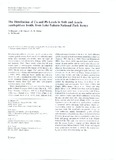| dc.description.abstract | Environmental pollution with toxic metals continues to be a serious global concern. Pollution of soils with toxic trace metals have increased considerably since the onset of industrialization and urbanization (Nriagu, 1990; Senwo and Tazisong, 2004).
Trace metals, either derived from natural inputs or anthropogenic emissions, are ubiquitous in the global environment (Blackmore, 1998; Muohi et al., 2003). Metals such as copper (Cu) and lead (Pb) are potentially toxic to living terrestrial and aquatic ecosystems (USEPA 1995).
Although heavy metals are naturally present in soils, contamination comes from local sources, mostly industrial effluents, agricultural activities, urbani domestic wastes, fossil fuels and other anthropogenic activities (Aksoy et al., 2000a).
Heavy metal pollution in soils and plants has been re¬ported in Brazil (Campos, 2003), Florida (Ma et al., 1997), Kenya (Wandiga and Onyari, 1987; Maskall and Thornton, 1996), India (Kuhad et al., 1989), China (Chen et al., 1991), Canada (Frank et al., 1976), Syria (Khuder et al., 1998) and South Carolina (Franklin et al., 2003). Elevated soil Pb, As and Cu levels have been reported in orchard soil (Francek, 1997; Aten et al., 1980; Peryea and Kammereck, 1997). Pyatt (1999, 2001) reported heavy metal concentrations in pine needles and in acacia trees (Acacia retinoides) from Cyprus and these plants were found to act as effective bioaccumulators of heavy metals.
The metal concentrations were also investigated in the soils and plants (Bowell and Ansah, 1994) in Ghana. Botanical materials such as fungi, lichens, tree bark, tree leaves and tree rings of higher plants have been used to detect the deposition, accumulation and distribution of metal pollution.
Plants are suitable for monitoring the heavy metal levels in the environment and consequently Scots pines (Yilmaz and Zengin, 2004), acacia (Aksoy et al., 2000a) and other plants (Aksoy et al., 2000b) have been used for bio-monitoring of heavy metal levels in ecosystems. Lake Nakuru National Park is a closed drainage basin and the catchment areas include a highly agricultural community surrounding the park, an urban area with a fast growing human popu¬lation, and an industrial sector (Raini, 1995).
The major vegetation type of the park is A. xanthophloea woodland, an important habitat for many wild animals, which pro¬vides nesting places and shelter for many resident and migratory birds. The woodland also provides forage for large herbivores, mainly Rothschild's giraffe (Giraffa camelopardalis rothschildii and black rhinoceros (Diceros bicornisi.
In recent years, Acacia xanthophloea trees have been undergoing unexplained dieback in Lake Nakuru National Park. This study was therefore undertaken to assess the current levels of copper and lead, identify the sources in Lake Nakuru National Park, Kenya, and suggest some conservation measures to alleviate the serious ecological pollution problems facing the lake. | |

